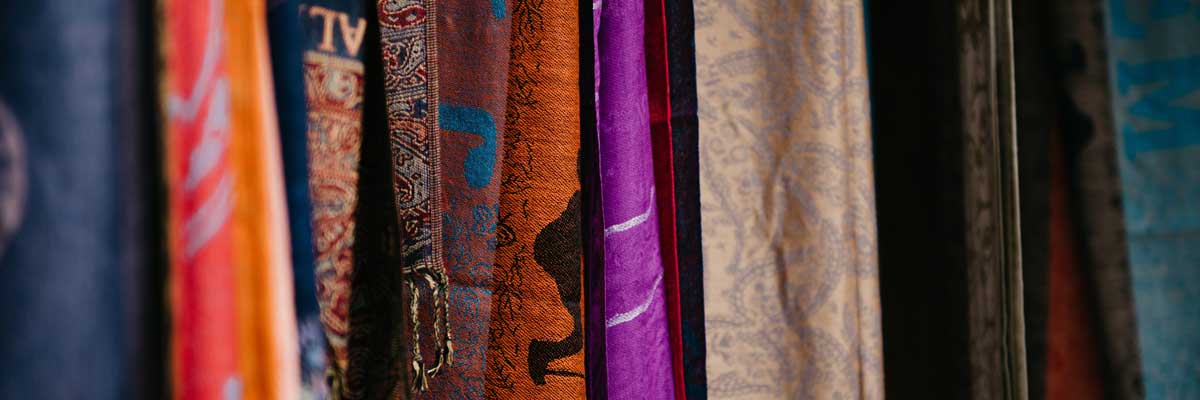There are many common fabric types that have been developed over the course of human history. This article will help answer some common questions about fabric types and what they are made from.
So Many Fabric Types!
Humans are ingenious and find all sorts of resources to fill their needs. The need for clothing to protect us from the elements drove us to wear skins and furs. Eventually, we learned how to create wool and silk. When agriculture was developed we learned how to use plant fibers to create our clothes. Eventually, exploration and trade lead to creating fabric for trade, or for use as ship’s sails and ropes. As technology improved, we discovered how to make synthetic fibers for all sorts of scientific and practical uses.
How Many Types Of Cloth Material Are There?
The website textileschool.com lists and catalogs over 80 types of fabric. On their site, you can find a huge variety of different types of fabrics with names and pictures. Along with the types of fabric with pictures, you can find a detailed description of each type of fabric.
What Are The 3 Types Of Fabric
Textiles are commonly made from 3 types of fabric:
- Animal Fibers
- Plant fibers
- Synthetic Fibers
The type of fabric used depends on the application. The fabric used for clothes is different from the fabric used for ship sails for instance. The fabric used to make bulletproof vests is going to be different than fabric made to keep you cool and dry.
What Are The Different Types Of Fabrics?
Textiles come from a variety of materials spun into thread then woven by different methods. Some are made from natural sources, such as plant fibers from cotton, flax, or hemp, and animal fur fibers, such as sheep, rabbits, and goats. Some cloth materials are made from synthetic sources, such as polyester and rayon. The variety of fabrics grows largely from the demand for practical and decorative use of textiles.
- Cotton (Plant Fiber, Cellulose) – Cotton is a natural fiber derived from the boll of the cotton plant. A boll is a seedpod. In cotton, the boll is a fluffy protective case that forms around the seeds of the cotton plant. In nature, the wind catches the cotton fibers and helps disperse the seeds. Cotton fabrics are known for being lightweight, soft, and absorbent.
- Linen (Plant Fiber, Cellulose) – Linen is a type of fabric made from the cellulose fibers that grow inside the stalks of the flax plant. Flax is one of the oldest-known cultivated plants in human history. Linen can also be made from the fibers that grow inside hemp stalks as well. Linen fabric is known for drying faster than cotton, being absorbent, and being strong. It is valued for its ability to stay fresh and cool in humid or hot conditions.
- Silk (Animal Fiber, Protein) – Silk is a natural fiber that can be woven into a fabric. Silk fibers are made from the cocoons of silkworm larvae. The best silk textiles are made from the cocoons of the mulberry silkworm larvae, which are grown in captivity for industrial purposes. Silk is known to help regulate temperature because it is breathable. It helps keep the wearer cool in hot weather and warm in cool weather. Silk is also valuable for its anti-fungal and hypo-allergenic properties.
- Wool (Animal Fiber, Fur) – Wool is a type of fabric textile made from the fur of sheep, goats, muskoxen, bison, rabbit, llamas, alpacas, and other animals. Wool is known for its excellent insulating properties. Wool keeps the wearer warm by trapping air between the fibers. It also helps wick moisture away from the body and helps evaporate it into the air, keeping the wearer dry.
- Rayon (Synthetic Fiber, Plants) – Rayon is a type of artificial silk made from highly processed plant fibers. Rayon is known for its moisture-absorbance, ease of dying, and not building up static electricity. It is soft on the skin, blends well with other fiber types, and is breathable and comfortable to wear.
- Polyester (Synthetic Fiber, Petroleum) – Polyester is a fabric made from processed petroleum. Polyester is popular for being wrinkle-resistant and drying quickly. Polyester fibers last a long time and polyester is popular for use as sports uniforms due to its durability.
- Nylon (Synthetic Fiber, Petroleum) – Nylon is a type of synthetic polymer-based material used to create a variety of consumer goods and apparel. Nylon is known for its durability, elasticity, as well as water and heat resistance.
You can see that there are a huge number of types and applications for different types of fabric.
Fabric vs. Textiles: What’s the Fabric Definition?
The terms fabric vs. textile can get confusing. The terms are actually interchangeable. The cloth and fabric meaning is the same; a type of woven textile.
Enjoy Fabrics!
Take a look around at your nearest fabric store and check out all the different types of fabric that can be found there. Get up and go browse a fabric store near you now! LOL – have fun enjoying the diverse and beautiful world of fabric and textiles.
 I Want To Know More About Fabric Types!
I Want To Know More About Fabric Types!
Enter your best email address - we respect your privacy.









